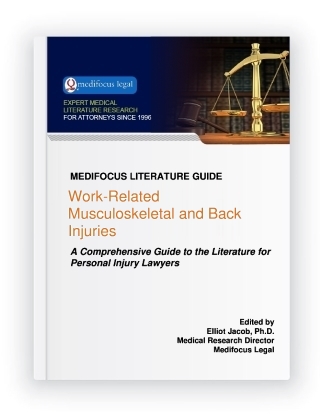Work-Related Musculoskeletal and Back InjuriesA Comprehensive Guide to the Literature for Personal Injury Lawyers
Publisher: Medifocus Legal
Publication Date: January 29, 2019
Number of Pages: 138
A Comprehensive Guide to the Literature for Personal Injury Lawyers
Publisher: Medifocus LegalPublication Date: January 29, 2019
Number of Pages: 138
Work-related risk factors for musculoskeletal injuries primarily involve occupations that require repetition, force, awkward position, and vibration. The occupational medicine literature has consistently demonstrated poor outcomes for work-related musculoskeletal disorders, particularly those involving the lower back. Despite relatively high levels of medical care, a substantial minority of workers with a chronic musculoskeletal disorder suffer disability and file for workers' compensation. Studies have found that workers with occupational back injuries, particularly African-Americans and younger adults, encounter long-term financial and domestic hardships that can persist at even 5-years after claim settlement.
When employees sustain a musculoskeletal injury, they can be approved for workers' compensation benefits if there is evidence of a significant causal relationship between the injury and the claimant's occupational duties. Since musculoskeletal injuries are also common within the general population and can result from non-work-related activities, such as a sports-related injury or a pre-existing condition, an employees claim may be denied on the basis that it was not work-related. Because work-related injuries are associated with significant direct and indirect costs to employers, insurers, and injured workers, litigation of these claims often follows.
The MediFocus Literature Guide to Work-Related Musculoskeletal and Back Injuries is a comprehensive reference Guide to the medical and occupational medicine literature for attorneys who are frequently involved in litigating cases related to an occupational back injury or other work-related musculoskeletal disorders. The Guide contains over 150 journal article references with links to the article abstracts and also includes a valuable Author Directory that enables attorneys to quickly identify and locate experts with specialized knowledge about work-related musculoskeletal injuries for case evaluations and expert testimony. The Guide will prove to be a valuable addition to the library of any attorney whose scope of practice includes litigating claims arising from occupational back injuries and other work-related musculoskeletal disorders.
 |
- A comprehensive bibliography of 152 journal article references indexed in MEDLINE published in well respected medical and scientific journals.
- Online access to the abstracts (summaries) of the articles.
- A unique "Author Directory" consisting of the names and institutional affiliations of experts who have published and have specialized knowledge about Work-Related Musculoskeletal and Back Injuries. The "Author Directory" is a valuable resource for quickly identifying and locating experts for case reviews, opinions, and testimony.
Select examples of topics that are covered by the articles referenced in this Guidebook include:
- Contribution of occupational factors to the incidence and persistence of chronic low back pain among workers
- Lag Times in Reporting Injuries, Receiving Medical Care, and Missing Work: Associations With the Length of Work Disability in Occupational Back Injuries.
- Low back pain, intervertebral disc and occupational diseases.
- Similarities between work related musculoskeletal disorders and slips, trips and falls.
- The combined effect of physical, psychosocial/organisational and/or environmental risk factors on the presence of work-related musculoskeletal symptoms and its consequences.
- Early predictors of lumbar spine surgery after occupational back injury
- Neck and back pain and intervertebral disc degeneration: role of occupational factors.
- Legal sequelae of occupational back injuries: a longitudinal analysis of Missouri judicial records.
- Causal assessment of occupational lifting and low back pain: results of a systematic review.
- Causal assessment of occupational carrying and low back pain: results of a systematic review.
- Administrative delays and chronic disability in patients with acute occupational low back injury.
- The recovery patterns of back pain among workers with compensated occupational back injuries.
- Disability determination: validity with occupational low back pain.
- Work-related musculoskeletal disorders of the hand and wrist: epidemiology, pathophysiology, and sensorimotor changes.
- Prediction of chronic disability in work-related musculoskeletal disorders: a prospective, population-based study.
- The relative importance of whole body vibration and occupational lifting as risk factors for lowback pain.
- Risk factors associated with the transition from acute to chronic occupational back pain.
- Recurrent disabling work-related spinal disorders after prior injury claims in a chronic low back pain population.
- Outcomes in work-related upper extremity and low back injuries: results of a retrospective study.
- Work-related musculoskeletal disorders among construction workers in the United States from 1992 to 2014.
is available in two formats: | |
Order by Phone:To order by phone, please call: Order by Mail:To order by mail, please print and complete this Order Form | |

